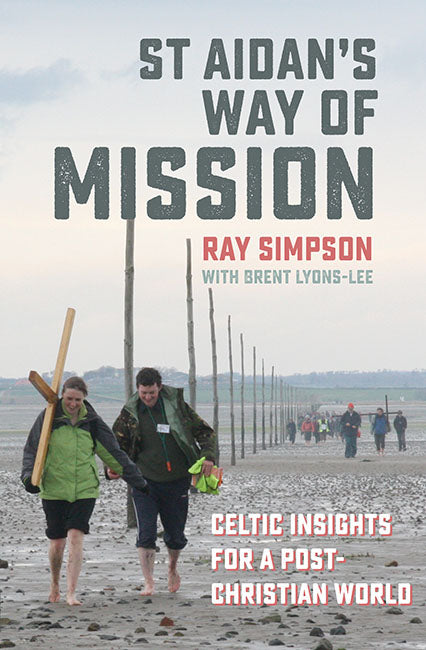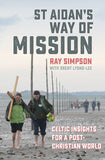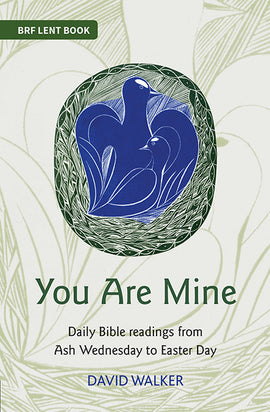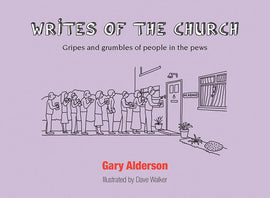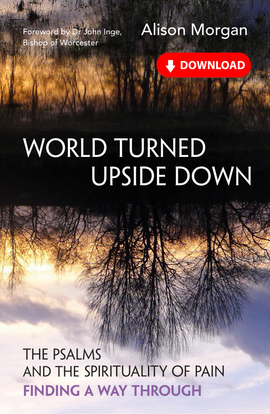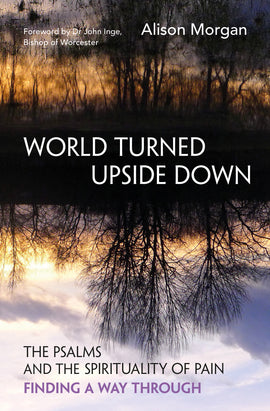St Aidan's Way of Mission: Celtic insights for a post-Christian world
Surveying the life and times of Aidan of Lindisfarne, this book draws insights into missional approaches to inspire both outreach and discipleship for today's Church. As in his previous BRF book, Hilda of Whitby, Ray Simpson shows that such figures from past centuries can provide models for Christian life and witness today. An author and speaker on Celtic spirituality with a worldwide reputation, he combines historical fact with spiritual lessons in a highly accessible style, with an appeal to a wide audience.
| Title | St Aidan's Way of Mission: Celtic insights for a post-Christian world |
| Author | Ray Simpson |
| ISBN | |
| Description | Surveying the life and times of Aidan of Lindisfarne, this book draws insights into missional approaches to inspire both outreach and discipleship for today's Church. As in his previous BRF book, Hilda of Whitby, Ray Simpson shows that such figures from past centuries can provide models for Christian life and witness today. An author and speaker on Celtic spirituality with a worldwide reputation, he combines historical fact with spiritual lessons in a highly accessible style, with an appeal to a wide audience. |
| Details |
|
Surveying the life and times of Aidan of Lindisfarne, this book draws insights into missional approaches to inspire both outreach and discipleship for today's Church. As in his previous BRF book, Hilda of Whitby, Ray Simpson shows that such figures from past centuries can provide models for Christian life and witness today. An author and speaker on Celtic spirituality with a worldwide reputation, he combines historical fact with spiritual lessons in a highly accessible style, with an appeal to a wide audience.
Ray Simpson is the Lindisfarne-based founder of a new monastic movement, the Community of Aidan and Hilda. His Australian co-author, Brent Lyons-Lee, is an expert in indigenous mission initiatives.
At one point, the authors commend the practice of lectio divina. It means 'godly reading', and is based around the four Rs of reading, reflection, response, and relaxing. It serves them well. Often, all there is to go on is fleeting insights into Aidan's life from Bede. But, in the spiritual realm, a little goes a long way. The Irish saint's very name means 'little flame'. From the book's first chapter - 'Incarnational and indigenous mission' - we are carried straight to religious flashpoints of contemporary importance.
Born at about the time that St Columba died, at the end of the sixth century, Aidan was commissioned from Iona to evangelise the brutally warring Anglo-Saxon settlers of Northumbria. Not for him the later Romanised colonial model of mission, a model replic ated from Australia to the Americas, where 'the gospel was preached, but abuse was modelled.' Instead, the Lindisfarne mission seeded 'little colonies of heaven' that helped to grow 'an indigenous, English-speaking church'.
I loved the chapter on 'Soul friends and lifelong learning'. Here we are reminded that, when universities were separated from a spiritual grounding in the Beatitudes, and Christ's relationship to nature, they lost 'a holistic understanding of godly learning that embraces head, heart and hands'. Other chapters explore pilgrimage, women as spiritual foster-mothers, social justice, and religious rule and rhythm.
There are those who would see 'Celtic Christianity' dead and buried. There are those who believe the future to be post-Christian. This little gem is a lectio divina of the signs of resurrection.
Dr McIntosh is an Honorary Fellow in divinity at Edinburgh UniversityProgressive Voices September 2016
This small book is an attempt to draw on the principles underpinning St Aidan's involvement in Celtic Christianity at its height, and apply them to our day. Although sometimes there's a slight element of 'St Aidan can do no wrong', it's important to say that the author is very clear about the mistakes of the representatives of both Roman and Celtic Christianity in Saxon Britain.
The chapters tackle topics ranging from church and state to the environment, the need for spiritual soul mates and the way the church continues to inflict inequality on women.
I think the heart of the book is in chapter 5. The author is sceptical of current models of doing Church and instead expounds the notion of the local expression of Christianity as a village of God. The following has become a bit of a mantra for the author:
- A 24-hour society calls for seven-days-a-week faith communities.
- A cafe society calls for churches that are eating places.
- A travelling society calls for churches that provide accommodation.
- A stressed society calls for churches that nurture retreats and meditation.
- A multi-choice society calls for churches that have a choice of styles and facilities.
- A fragmented society calls for holistic models and whole-life discipling.
- An eco-threatened society calls for more locally sustainable communities that have roots in the soil.
There are other pithy sayings of this sort, particularly in the chapter on church and state which develops into a brief summary of the author's thoughts on social justice issues.
The essential message of the book is that we have reached a point where Christianity needs re-rooting in British (and European) soil, that this will be a long process requiring patience and a long-term approach as exemplified by St Aidan's dealings with the ordinary person and nobility of his day.
Guy WhitehouseJournal of Contemporary Ministry No 2 (2016)
Aidan is an inspiring saint whose Irish mission to the English is an instructive model for mission in the post-Christendom Western world today, suggest Ray Simpson with Brent Lyons-Lee.
Ray Simpson is the founding Guardian and chief liturgist of the International New Monastic Community of Aidan and Hilda and author of over thirty books on spirituality and mission. Brent Lyons-Lee is Mission Catalyst for Community Engagement with the Baptist Union of Victoria and a social justice activist. This is his third book he has co-written with Ray Simpson connecting Celtic insights with spirituality that can be at home in Australia.
The story began when Aidan was posted to the Iona monastery. When a previous mission effort to Northumbria failed, Aidan was sent from Iona to Northumbria in 635. He learned English, built trust with King Oswald and his court, and walked around the region seeking to incarnate the gospel and create indigenous 'colonies of heaven.'
I loved the invitation of the book to reflect on Aidan's example of the Christian life as a pilgrimage, not a possession. Irish pilgrims or peregrine allowed God's Spirit to blow them where it wished and let mission take as long as it needed. As reflected in vows of the Community of Aidan and Hilda, it is about setting sail and letting the 'Wild Goose' or untameable Spirit of God lead into wild or windy places, and then make them places of welcome and wonder. To find your calling, Simpson often says, 'Let your feet follow your heart until you find your place of resurrection' (p. 29). The place of resurrection is about not only where you will literally die, but also where you can experience shalom and harmony between yourself and your place and neighbours (and so where you may as well stay until you die). It is where 'fruit comes as a gift because we are the right person in the right place at the right time. Creativity flows. Connections take place. Synchronicity occurs. Jesus is revealed' (p. 29). That is sufficient vision to invite us to let go of what we hold (and what holds us) and step out on a Spirit-led journey, and keep walking till we find a place where the bells ring for us.
The second inspiring lesson I got from this book is that, rather than viewing the church as institutional and attractional, do-it-yourself or even focused on mission only, Aidan's vision of church was as 'God-shaped hub communities that have a heart for God, others and society' (p. 87). Starting in Lindisfarne, Aidan planted a network of monastic communities that included schools, libraries and guest quarters, and space for productive farming as well as celebratory feasting. Simpson suggests today's global village still needs churches as 'villages of God':
- A 24-hour society calls for seven-days-a-week faith communities.
- A cafe society calls for churches that are eating places.
- A travelling society calls for churches that provide accommodation.
- A stressed society calls for churches that nurture retreats and meditation.
- A multi-choice society calls for churches that have a choice of styles and facilities.
- A fragmented society calls for holistic models and whole-life discipling.
- An eco-threatened society calls for more locally sustainable communities that have roots in the soil.
This is a model of church functioning in ways that are responsive to one's adopted city and seeking to foster shalom.
Aidan also celebrated the image and gifts of God in women as well as men. Aidan prioritised practices and rhythms, and I appreciated the writer's urging to identify practices worth commending to people in my community. Moreover, Aidan had a grounded vision of an earthy faith that cares for Creation. The book is practical about how to do this, but also beautifully weaves together Celtic and Australian indigenous stories.
Finally, Simpson and Lyons-Lee stressed the importance that Aidan taught of having soul friends who help us cultivate balanced and prayerful living and a lifelong love for learning wisdom. Aidan's spirituality and teaching were not focused only on book learning but also on cultivating a deep devotion, as this prayer urged:
Divine Mentor,
Teach us the habits of holy learning,
To know your ways
To explore your world
To learn from experience
To understand people
To manage time and talents
To draw on wellsprings of wisdom
Until we become a people of saints and scholars (p. 47).
The Church in the West does not need another one-size-fits-all off-the-shelf program. However, we do need stories of saints who have walked journeys of courageous faith and adventurous mission - not to imitate closely but to suggest principles and ways of engaging our neighbourhoods in fresh and humble ways. St Aidan's Way of Mission is a delightful read, weaving together the story of this inspiring saint and implications for contemporary ministry.[p>] Dr Darren Cronshaw
Ray Simpson's writing is readable and thought-provoking. The subtitle for this book is 'Celtic insights for a post-Christian world', and is a helpful reminder how valuable the insights of the Celtic saints are for the challenges we face today. The authors reflect on life as a Christian in a world that has lost touch with a deeply-rooted spirituality, returning to the mission of St Aidan and his deep desire to bring the relevance of Christianity to day to day life. They explain the relevance of Aidan in the globally dangerous world we find ourselves in and remind us of the call to live the eternal values of Christianity, but also the need to ensure we are culturally relevant. Lyons-Lee brings an Australian cross-cultural mission perspective and contributes an interesting angle to the spirituality of place and how this relates to the Celtic church.
Aidan was a man of his time (seventh century), yet in the great missions of the nineteenth and twentieth centuries, many missionaries dispersed from Britain and Ireland, and clearly could not have done this had it not been for the work of their forefathers and mothers. Simpson and Lee remind us for the need for a 'bottom up' rather than a 'top down' culture of mission. They argue that the question of whether we are post-Christian relates closely to our post-colonial heritage, taking in the strands of evangelism and the prosperity gospel, and other negative forms of Christianity which favour the few. They demonstrate the model of mission where networks and communities have justice integrated within them.
Celtic women feature strongly, and certainly I was left wanting more of the great women who are considered the key Celtic saints- Hilda Brigid and Bega. They are women who could offer a lot to our churches and different models of leadership and ministry. When the writers state that in the history of Christianity, only three countries have routinely dignified them by appointing them to lead large monasteries of women and men, I would have liked to know more of these women within the German, French and English traditions. I can imagine some of the names that would be included here, but found myself wondering about these founders about whom little is known, women who were known for leadership and soul friendship and would have been the early spiritual directors. This book raises important questions and the chapter focussing particularly on women would be a creative study for our 'Catholic Women's Ordination' groups.
Katharine Salmon

